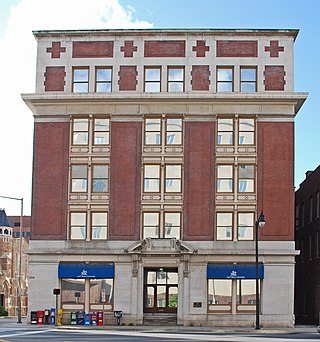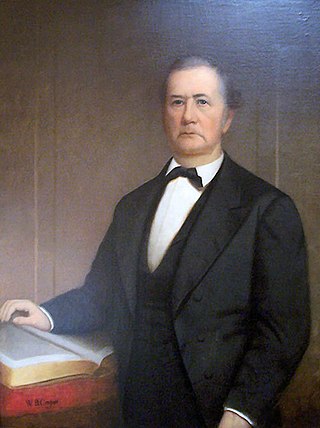
Mount Olivet Cemetery is a 206-acre (83 ha) cemetery located in Nashville, Tennessee. It is located approximately two miles East of downtown Nashville, and adjacent to the Catholic Calvary Cemetery. It is open to the public during daylight hours.

Marr & Holman was an architectural firm in Nashville, Tennessee known for their traditional design. Notable buildings include the Nashville Post Office and the Milliken Memorial Community House in Elkton, Kentucky.

The Clarksville Historic District is a national historic district located at Clarksville, Mecklenburg County, Virginia. It encompasses 171 contributing buildings, 2 contributing sites, and 1 contributing structure in the central business district and surrounding residential areas of the town of Clarksille. Notable buildings include the Planters Bank (1909), Planters Brick Tobacco Sales Warehouse, Gilliland Hotel, the Russell's Furniture, former Clarksville High School (1934), Clarksville Presbyterian Church, Mount Zion Baptist Church, Jamieson Memorial Methodist Episcopal Church (1901), St. Timothy's Episcopal Church (1917), and St. Catherine of Siena Roman Catholic Church (1947). Located in the district are the separately listed Clark Royster House and the Judge Henry Wood Jr. House.

The University of Tennessee at Nashville was a branch campus of the UT system which existed from 1968 to 1979.

Clarksville Methodist Church is a historic church building at 334 Main Street in Clarksville, Tennessee. Currently, the building isn't used as a church.

Madison Street United Methodist Church is a historic church at 319 Madison Street in Clarksville, Tennessee. The church is a brown brick building that exemplifies Gothic architecture of the Victorian era. It was listed on the National Register of Historic Places in 1976.

Trinity Episcopal Church is a historic church at 317 Franklin Street in Clarksville, Tennessee. The church and its rectory are listed on the National Register of Historic Places as Trinity Church and Rectory.
The following is a timeline of the history of the city of Nashville, Tennessee, United States.

Scarritt College for Christian Workers was a college associated with the United Methodist Church in Nashville, Tennessee, USA. The campus is now home to Scarritt Bennett Center.

Alexander Little Page Green was an American Methodist leader, slaveholder, and co-founder of Vanderbilt University. He was the founder of the Southern Methodist Publishing House. He was instrumental in moving the Methodist General Conference to Nashville, Tennessee, where he was the minister of McKendree United Methodist Church. He was an authority on fishing.
Church Street is a major thoroughfare in Nashville, Tennessee. It is home to several skyscrapers and buildings listed on the National Register of Historic Places.

The Carthage United Methodist Church is a historic church in Carthage, Tennessee, USA.

Longview is a historic mansion in Nashville, Tennessee, USA.

The Frost Building is a historic building in Nashville, Tennessee, USA. It was built in the 1910s for the Southern Baptist Convention.

The McGavock-Gatewood-Webb House, also known as Blue Fountain, is a historic house in Nashville, Tennessee, USA. It was built in the 1840s.

The Morris Memorial Building is a historic building in Nashville, Tennessee, United States. It was built in the 1920s for the African-American National Baptist Convention, USA, Inc. and was named for longtime president Elias Camp Morris.

Lindsley Hall is a historic building in Nashville, Tennessee. Built in the antebellum South as the main building of the University of Nashville, it served as a Union hospital during the Civil War. It became the Nashville Children's Museum in 1945. In 1974 the museum moved to a new facility at 800 Fort Negley Boulevard, became the Cumberland Science Museum and is now known as the Adventure Science Center. The building is once again called Lindsley Hall and is used by the City of Nashville for Metro Government offices.

Julia A. Tevis was a pioneer educator of women from Kentucky. After teaching for several years in Virginia, she founded the Science Hill Female Academy in Shelbyville and led the institution to gain a national reputation for excellence. Teaching her students math and science, rather than how to be accomplished seamstresses, Tevis prepared young women for colleges.
Donald W. Southgate (1887–1953) was an American architect. He designed many buildings in Davidson County, Tennessee, especially Nashville and Belle Meade, some of which are listed on the National Register of Historic Places.
Edwin Augustus Keeble was an American architect who was trained in the Beaux-Arts architecture tradition. He designed many buildings in Tennessee, including homes, churches, military installations, skyscrapers, hospitals and school buildings, some of which are listed on the National Register of Historic Places. He is best known for Nashville's landmark Life and Casualty Tower built in 1957 which was the tallest commercial structure in the Southeastern United States at that time. It reflected an architectural turn to modernism and was one of the first buildings emphasizing energy efficiency.


















